This set of Electrical Machines Multiple Choice Questions & Answers (MCQs) focuses on “Power Angle Characteristics of Synchronous Machines”.
1. Choose the correct power angle characteristics for the synchronous motor and generator.
a) 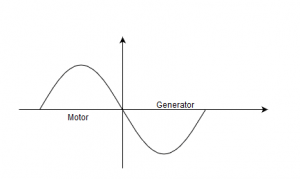
b) 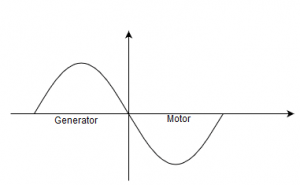
c) 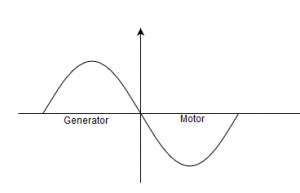
d) None of the mentioned
View Answer
Explanation: In the generator mode, the power is positive and it is taken out of the terminals.
2. For a 3 phase 400V alternator having 0.5pu of synchronous reactance and its excitation voltage of 1.2pu and Vt of 1pu. Then the power delivered to the infinite bus is?
a) 2.4pu
b) 4.8pu
c) 1.44pu
d) 1pu
View Answer
Explanation: P = EV/X = 1.2*1/0.5 = 2.4 pu.
3. For a 3 phase 400V alternator supplying a load of 0.8 pf lagging at an armature current of 1.1pu. The power delivered to load is?
a) 0.88pu
b) 0.7pu
c) 0.66pu
d) 1.375pu
View Answer
Explanation: Here V = 1pu; I = 1.1pu; pf = 0.8
Power = VIcosδ = 1 * 1.1 * 0.8 = 0.88pu
4. The power-angle characteristic for a three phase salient pole alternator is most correctly shown by?
a) 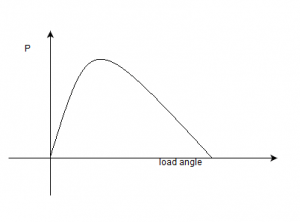
b) 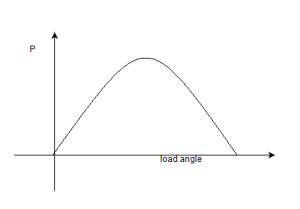
c) 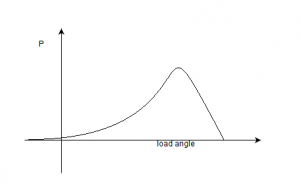
d) 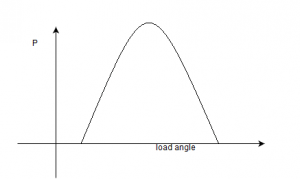
View Answer
Explanation: The power angle curve is not completely sinusoidal due to the salient nature of the poles.
5. A 3 phase 400V salient pole alternator is running at no-load. Suddenly the excitation is removed then the net power in the machine is proportional to _____________
a) sin 2d
b) sin d
c) cos 2d
d) 0
View Answer
Explanation: The reluctance power generated will be proportional to sin(2δ).
6. A 3 phase 400V cylindrical rotor is running at 1500rpm. Suddenly the field excitation zero. Then the net reluctance power is?
a) 0
b) sin 2d
c) cos d
d) cos 2d
View Answer
Explanation: The net reluctance power for a cylindrical rotor type alternator will be zero if the field excitation is made zero.
7. A cylindrical rotor alternator can also run as reluctance motor.
a) True
b) False
View Answer
Explanation: The net reluctance power for a cylindrical rotor type alternator will be zero if the field excitation is made zero. There will not be any torque generated.
8. If the synchronous machine is connected to an infinite bus of constant voltage Vt, through a transformed, a transmission line of reactance ‘X’. Then power for a cylindrical machine is?
a) P = (Ef*Vt sinδ)/(Xs + X)
b) P = (Ef*Ef sin2δ)/(Xs + X)
c) P = (Ef*Vt sinδ)/(Xs – X)
d) P = (Vt*Vt sinδ)/(Xs + X)
View Answer
Explanation: The total reactance will be the reactance offered to the synchronous motor in the machine.
9. Maximum power in cylinder rotor alternator occurs at load angle of __________
a) 90 degree
b) 45 degree
c) less than 90 degree
d) 180 degree
View Answer
Explanation: The maximum power will occur at exact 90° for a cylindrical rotor alternator.
10. A synchronous generator is operating with a Ef=1.40pu. This machine having Xs of 1.2pu, is delivering a synchronous power of 0.5pu to the bus. If the prime-mover torque is increased by 1%, by how much will the synchronous power P change?
a) 1%
b) 10%
c) -1%
d) 4%
View Answer
Explanation: dP/dδ = EVcosδ/X
So the change in P will also be 1%.
11. A synchronous generator is running over excited with a Ef=1.40pu. This machine, with a synchronous reactance of 1.2pu, is delivering a synchronous power of 0.5pu to the bus. If the prime-mover torque is increased by 1%, by how much will the reactive power, Q change?
a) -0.475 %
b) 0.475%
c) 4.75%
d) -4.75%
View Answer
Explanation: dQ/dδ = -EVsinδ/X
dP/dδ = EVcosδ/X
dQ/dP = -tanδ = -tan25.4 = -0.475
dQ = -0.475%.
12. A synchronous machine which is synchronized with an infinite bus. If it is desired to obtain a condition when the machine delivers the real power to the IBB without changing the field excitation, then __________
a) reactive power will be consumed by the machine
b) reactive power will be delivered by the machine
c) no reactive power flow will take place
d) none of the mentioned
View Answer
Explanation: Due to the condition here that it is providing the real power to the infinite bus bar here, the machine will need more flux to produce the real power in the machine.
13. The phasor addition of stator and rotor mmfs in a cylindrical rotor synchronous machine, is possible because __________
a) mmfs are rotating in opposite direction
b) mmfs are rotating in same direction at different speeds
c) mmfs are stationary with respect to each other
d) one mmf is stationary and the other mmf is rotating
View Answer
Explanation: The phasor addition is possible due to the fact that the two mmfs are stationary with respect to each other.
14. For the effective electromechanical energy conversion in the device, the developed torque depends upon __________
a) stator field and torque angle
b) stator field and rotor field
c) stator field and rotor field and the torque angle
d) stator field only
View Answer
Explanation: T α E*V*sinδ.
15. In a synchronous machine, hunting is predominantly damped by __________
a) mechanical losses in the rotor
b) iron losses in rotor
c) copper losses of stator
d) copper losses of rotor
View Answer
Explanation: The hunting is damped by the copper losses in the rotor.
Sanfoundry Global Education & Learning Series – Electrical Machines.
To practice all areas of Electrical Machines, here is complete set of 1000+ Multiple Choice Questions and Answers.
If you find a mistake in question / option / answer, kindly take a screenshot and email to [email protected]
- Check Electrical & Electronics Engineering Books
- Practice Electrical Engineering MCQs
- Check Electrical Machines Books
- Apply for Electrical Engineering Internship
- Apply for Electrical & Electronics Engineering Internship
